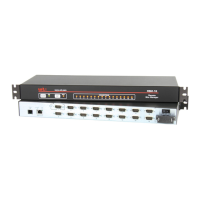5-45
Basic Configuration
TSM/RSM Units with Dual Ethernet Ports:
Both TSM-DPE series units and RSM-8R8-DE series units include two Ethernet ports.
This allows the two ports to either be dedicated to separate applications/users, or
employed to provide network fallback capabilities. In cases where the two Ethernet
ports will be used for separate applications, a separate IP address is assigned to each
port. In cases where the two Ethernet ports are used to provide fallback capabilities, the
same IP address is assigned to each Ethernet port. On dual Ethernet TSM/RSM units,
the top Ethernet port is port zero, and the bottom Ethernet port is port 1. In addition,
both Ethernet ports can be configured for both IPv4 and IPv6 protocols.
Note:InDualEthernetunits,allportparametersexcepttheIPAddress,Subnet
Mask,GatewayAddress,DHCPsettingandNegotiationsettingaresharedby
bothEthernetports.SharedparametersselectedforEthernetport0willalsobe
appliedtoEthernetport1.
To select network parameters for TSM/RSM units with dual Ethernet ports, proceed as
follows:
• TextInterface:
To define IPv4 parameters for Ethernet port zero, type /N0 and press [Enter].
To define IPv4 parameters for Ethernet port one, type, /N1 and press [Enter].
To define IPv6 parameters for Ethernet port zero, type /N6 0 and press [Enter].
To define IPv6 parameters for Ethernet port one, type /N6 1 and press [Enter].
• WebBrowserInterface: Although the Web Browser Interface cannot be used to
select non-shared parameters (i.e., IP Address, Subnet Mask, Gateway Address,
DHCP setting and Negotiation setting,) parameters that are shared by both
Ethernet ports can still be defined via Web. Place the cursor over the "Network
Configuration" link on the left hand side of the screen, wait for the fly-out menu to
appear, and then click on the link to display the desired menu. Some submenus
offer the option to define IPv4 or IPv6 parameters, in these cases, a flyout menu will
appear to allow the user to select IPv4 or IPv6.

